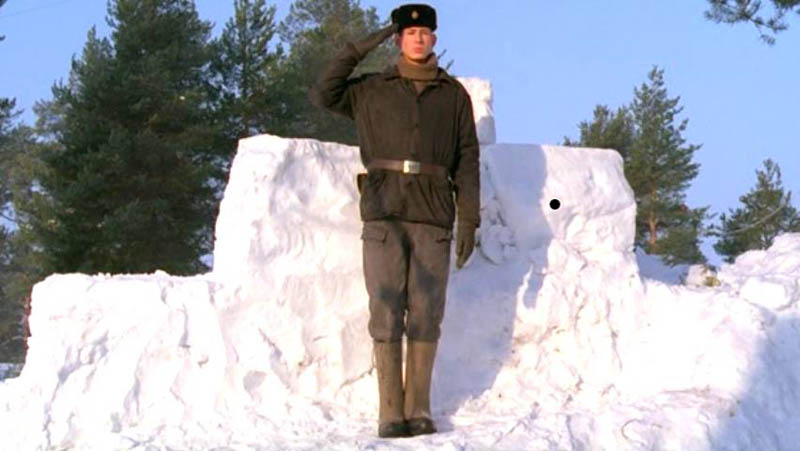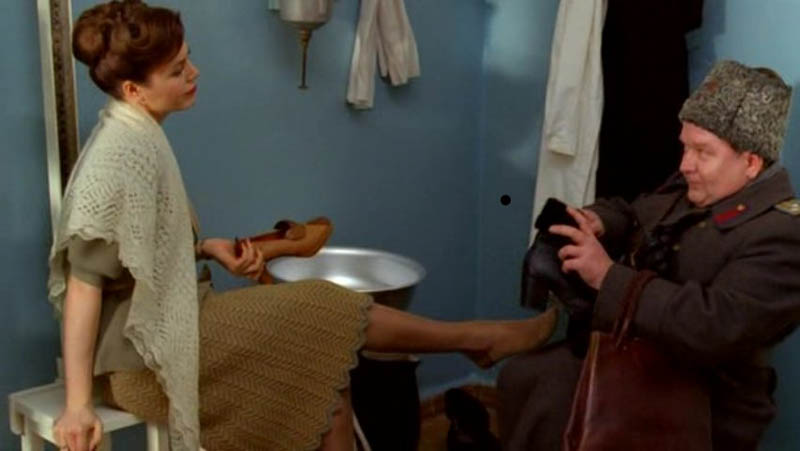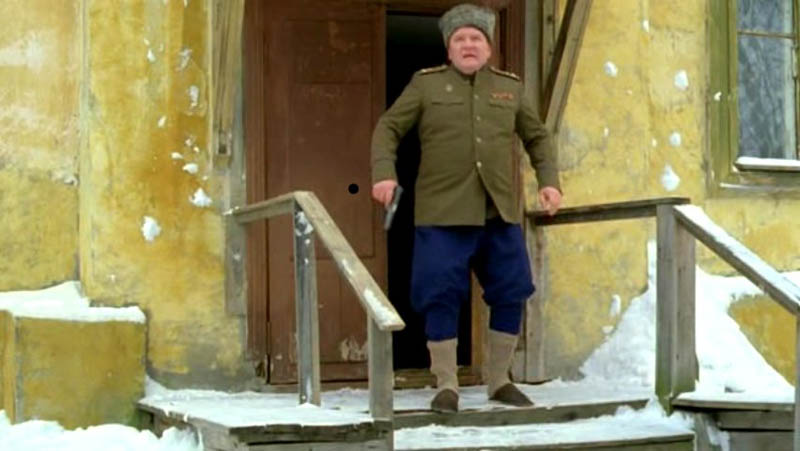The Stalin Era in Secondary Processing (Film Review Article)
Petya on the Road to the Kingdom of Heaven, 2009, produced by Fedor Popov, directed by Nikolay Dostal, 2009, written by Mikhail Kuraev, 97 min.
Since the glasnost years the Stalin era has become a popular topic in Russian cinema, and has also helped to draw attention to Russian film abroad. At the last Moscow Film Festival (2009), the Grand-Prix was once again conferred on a picture about the Stalin era, Nikolai Dostal’s Petya on the Road to the Kingdom of Heaven [Petya po doroge v Tsarstvie Nebesnoe]. However, unlike Dmitry Meskhiev’s Us [Svoi] (2004), which was distinguished not only by high cinematic quality but also by an innovative ideological approach, and whose triumph at the festival 5 years ago came as strong evidence of Russian cinema’s revival, the success of Petya was somewhat puzzling, and was not followed by any significant public or critical acclaim. It seems that the film’s awkward status and rather ambiguous messages (that will be examined below) reflect not only a rather baffling course of the development in Russian cinema, but also, somewhat indirectly, the painful hesitations in the Russian cultural establishment regarding its attitude towards Stalinism. As a matter of fact, these hesitations were revealed a bit later, when, first, Stalin’s biography was published in the famous “Lives of Remarkable People” book series, and then followed the formal condemnation of the Katyn massacre.
Since the early 2000s, interest in the screen image of the Stalin era started to shift from the recent past to the more distant historical past (such as the eras of Peter the Great or the Decembrists). It is not that any terrifying aspects of Soviet history were obscured; on the contrary, the violence and starvation in prison camps and the blood-thirstiness of NKVD executioners were shown in a more elaborate manner than ever before. Many of these new films and TV series were based on works by writers such as Solzhenitsyn or Shalamov, whose subject, means of expression, and history made them essentially oppositional to official Soviet culture. These works suddenly became source material for a production line of costume dramas, complete with a standard set of clichés and produced primarily by the state-run Channel One; one may say that the Soviet past has thereby undergone a “secondary processing.”
This phenomenon also coincides with a new wave in architecture that imitates the Stalinist Empire style and a fad for reprints of postcards and posters of the 1920-1950s, whose propagandist messages can now be perceived as merely funny or even cute. One might easily determine that the Stalin era is being transformed from a painful topic in national memory into an object of mass consumption, a commodity brand with which one can “sell” both terrifying and curious phenomena with equal success.
At least on the surface, however, Petya and a few other recent films—such as A Gift to Stalin [Podarok Stalinu] (Rustem Abdrashev, 2008) and Kind People [Lyudi dobrye] (Alexei Karelin, 2009)—show something of a counter-tendency. They demonstrate a revival of the trend in the post-Soviet cinema of the 1990s that was concerned with depicting out-of-the-way locations during the postwar years, where people of different backgrounds were forced to live close to one another in communal apartments and barracks. Many of these films–such as Pyotr Todorovsky’s Encore, Once More Encore! (1992) and What a Wonderful Game (1996), Savva Kulish’s The Iron Curtain (1994), Lev Kulidzhanov’s Forget-me-nots (1994), Leonid Maryagin’s The 101st Kilometer (2001), and Pavel Chukhray’s celebrated The Thief [1997]–were autobiographical, since the youth of the filmmakers occurred in the postwar period and they could therefore be considered to be products of “primary processing.”
These films shunned ideological evaluation of the Stalin era, portraying it not as a kingdom of evil (as the revelatory dramas of Perestroika did), but, rather, as a chain of peculiar accidents. There were no noble heroes who were doomed to become victims of infernal executioners; their characters, having simple human weaknesses, faced mundane, everyday-life problems. Emphasis was put on the background of the epoch, not its facade. For the most part, the films of the 1990s depicted communal coexistence with an obviously nostalgic atmosphere, letting their cinematic narrative add a dose of lyricism to the whole.
A Gift to Stalin is imbued with elements of this tradition. It tells a sentimental story about a little Jewish boy who is exiled to Kazakhstan, where he escapes from a prison train and manages to survive because an old shell-shocked Kazakh, an exiled Pole, and the Russian widow of a political prisoner take care of him and, not without some sacrifice, save him from the police and the cruel NKVD. Using the familiar (though fictional) frame of autobiographical reminiscence and replicating many of the distinctive clichés of the retro-films of the 1990s, A Gift to Stalin appears quite old-fashioned. Dostal’s Petya seems to fuse that tradition with stylistic elements typical of mid-2000s costume dramas (Dostal himself directed one of the best, 2004’s Shtrafbat), and yet it diverges from their genre conventions in certain significant respects.
Following the tradition, it portrays the Stalin era as a time full of contrasts, usually to the point of absurdity–cheap and phony symbols of prosperity and stateliness are set amid poverty and wretchedness. Communal co-existence is shown as an idyllic setting in which people always selflessly help each other, while officers of the MGB (former NKVD and future KGB) appear as cruel alien figures who torment the people for their own enjoyment. Each supporting character is presented as a schemer, and the characters’ masks fall away at times to reveal glimpses of an enigmatic history. In one such moment, the mine director Konovalov, in spite of his plebeian facial features and manners, brilliantly plays a famous Gypsy hit on the piano, thus revealing his hidden intelligentsia origins.
 The features of Petya that diverge from traditional Stalinist era depictions start with the protagonist. In his debut performance, Egor Pavlov plays Petya, a mentally-challenged young man who believes that he is a traffic policeman. Apparently taking him for a holy fool, those around him care for Petya, since offending such a person has always been regarded a great sin in Russia. In Russian movies of the 1990s, childishness was often depicted as a quality that enabled protagonists to survive when those around them perished (Gift to Stalin follows that pattern). The juvenile behavior of the quite grown-up Petya, however, is revealed in his atrophied sense of danger and this leads to his death.
The features of Petya that diverge from traditional Stalinist era depictions start with the protagonist. In his debut performance, Egor Pavlov plays Petya, a mentally-challenged young man who believes that he is a traffic policeman. Apparently taking him for a holy fool, those around him care for Petya, since offending such a person has always been regarded a great sin in Russia. In Russian movies of the 1990s, childishness was often depicted as a quality that enabled protagonists to survive when those around them perished (Gift to Stalin follows that pattern). The juvenile behavior of the quite grown-up Petya, however, is revealed in his atrophied sense of danger and this leads to his death.
It is noteworthy that Petya gets killed after Stalin’s death; perhaps he is too much bound up with the Stalin era, sharing many of its salient features such as its love of pageantry combined with genuine and naive enthusiasm: he wears war medals borrowed from friends, and uses vulgar bureaucratic idioms. Towards the end of the film, he stands beside his snow replica of Lenin’s mausoleum and salutes a column of prisoners convoyed to a newly-built camp. Shortly afterwards two of the more sinister prisoners escape and, during their pursuit, Petya is mistakenly killed. Such a resolution conveys a startlingly ambiguous message. One may read it as the killing of an innocent soul by the cruelty cultivated by the Stalin regime. On the other hand, the protagonist’s death may be more intimately linked to Stalin’s regime–his death perhaps owing to the fact that the regime had come to an end. After all, as long as it lasted, the holy fool Petya was treated with some kind of respect while bandits were dutifully punished.
 The film’s confrontation between the intelligentsia and the NKVD also deviates from the stereotypes of Russian cinema in the Stalin years. According to standard depictions, the intelligent, masculine, and noble Jewish doctor Joffe would be expected to be cruelly killed or, in the best possible scenario, imprisoned (the beginning of 1953 was the climax of the post-war anti-Semitic campaign). In Petya, not only does Joffe survive, but he actually becomes the lover of the garish wife of Boguslavsky, an MGB colonel–and gets away with it. Instead of proving his moral integrity and paying for it, Joffe emerges as a mischievous adulterer and object of manipulation in the hands of an unscrupulous and shameless tart (although kind-hearted and compassionate, according to the Marlene Dietrich tradition), who uses him to avenge herself on the man who offended her (she married Boguslavsky after he imprisoned her previous husband).
The film’s confrontation between the intelligentsia and the NKVD also deviates from the stereotypes of Russian cinema in the Stalin years. According to standard depictions, the intelligent, masculine, and noble Jewish doctor Joffe would be expected to be cruelly killed or, in the best possible scenario, imprisoned (the beginning of 1953 was the climax of the post-war anti-Semitic campaign). In Petya, not only does Joffe survive, but he actually becomes the lover of the garish wife of Boguslavsky, an MGB colonel–and gets away with it. Instead of proving his moral integrity and paying for it, Joffe emerges as a mischievous adulterer and object of manipulation in the hands of an unscrupulous and shameless tart (although kind-hearted and compassionate, according to the Marlene Dietrich tradition), who uses him to avenge herself on the man who offended her (she married Boguslavsky after he imprisoned her previous husband).
 The actor playing Boguslavsky, Roman Madyanov, is by no means new to the role of Soviet apparatchik, having been celebrated for his appearance as an NKVD villain in Dostal’s Shtrafbat, and again later for playing the notorious MGB head Abakumov in Gleb Panfilov’s adaptation of Solzhenitsyn’s The First Circle (2007). As Boguslavsky, however, he looks quite different: even fatter and flabbier, but less dangerous and powerful. He is intimidating only when shouting, but is in fact incapable of fulfilling any of his threats; the chief guard at the camp, whom he scolds for letting barbed wire be stolen, shows no sincere fear of punishment. Boguslavsky even asks Joffe to keep an eye on his wife to make sure she is faithful and ultimately ends up a ridiculous cuckold. In fact, this very helplessness of Boguslavsky may suggest that NKVD/MGB people were not as terrible as is generally believed and that the Jews were not as severely harassed, but actually managed to get away from real trouble by resorting to some crafty ruses. lesbian gay movies collection
The actor playing Boguslavsky, Roman Madyanov, is by no means new to the role of Soviet apparatchik, having been celebrated for his appearance as an NKVD villain in Dostal’s Shtrafbat, and again later for playing the notorious MGB head Abakumov in Gleb Panfilov’s adaptation of Solzhenitsyn’s The First Circle (2007). As Boguslavsky, however, he looks quite different: even fatter and flabbier, but less dangerous and powerful. He is intimidating only when shouting, but is in fact incapable of fulfilling any of his threats; the chief guard at the camp, whom he scolds for letting barbed wire be stolen, shows no sincere fear of punishment. Boguslavsky even asks Joffe to keep an eye on his wife to make sure she is faithful and ultimately ends up a ridiculous cuckold. In fact, this very helplessness of Boguslavsky may suggest that NKVD/MGB people were not as terrible as is generally believed and that the Jews were not as severely harassed, but actually managed to get away from real trouble by resorting to some crafty ruses. lesbian gay movies collection
Lacking the conventional cause-and-effect logic, Petya on the Road to the Kingdom of Heaven, like Karelin’s Kind People and Abdrashev’s A Gift to Stalin, follows the narrative logic of a dream, where archetypes of the collective unconscious, mass culture imagery, and national complexes become randomly mixed (as the unmotivated dreamlike musical soundtrack of Kind People proves that with a vengeance). Struggling with the alienation from the country’s history that has manifested itself in recent costume dramas and trying to offer a more direct and less formulaic way of representing it, these films, with their limping narratives full of blank spots, fail to grasp it as a cohesive whole (as the best films of the 1990s often did). Instead, we see a flow of incoherent hackneyed images borrowed from preceding films that quickly sink into oblivion in the foreign, disjointed landscape of this new depiction of recent history. This shift in representational strategies points to the disappearance of the Stalin era from the collective memory, which means, in turn, that a “secondary processing,” or reimagining is doomed to come out on top as the primary mode of its depiction.




